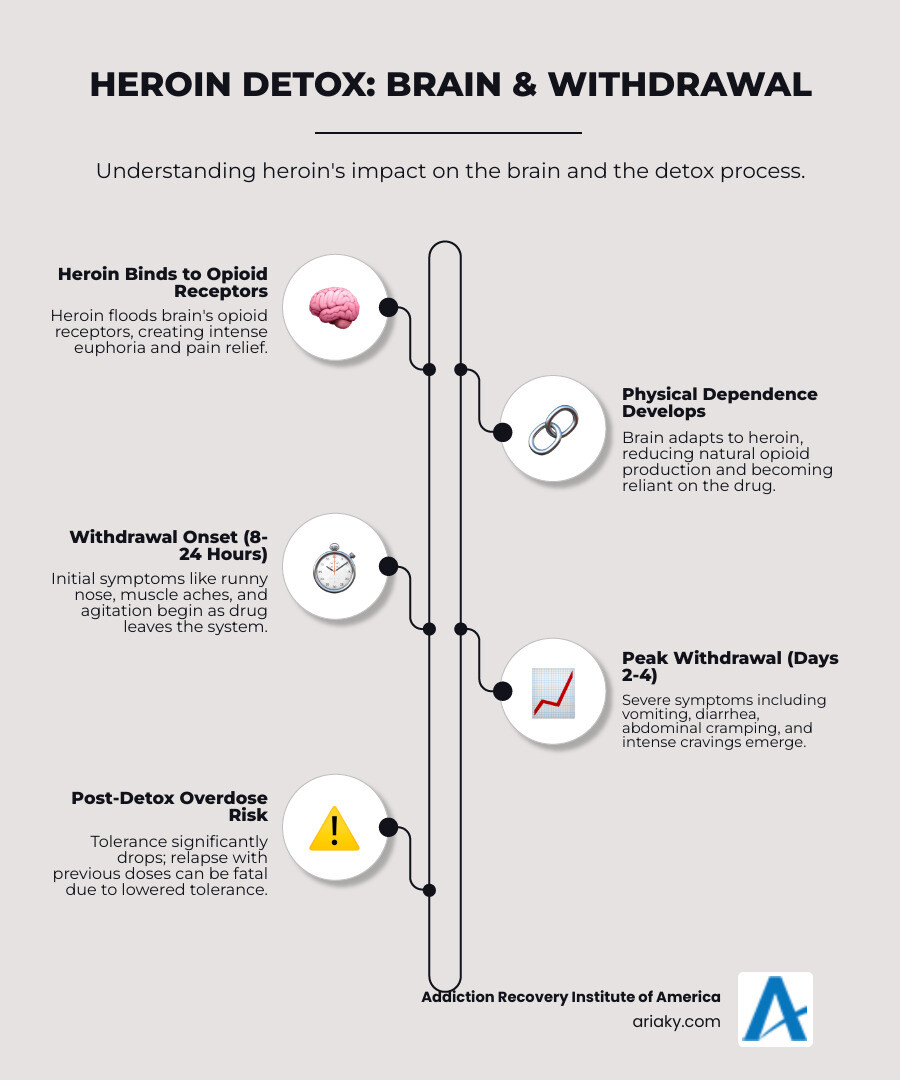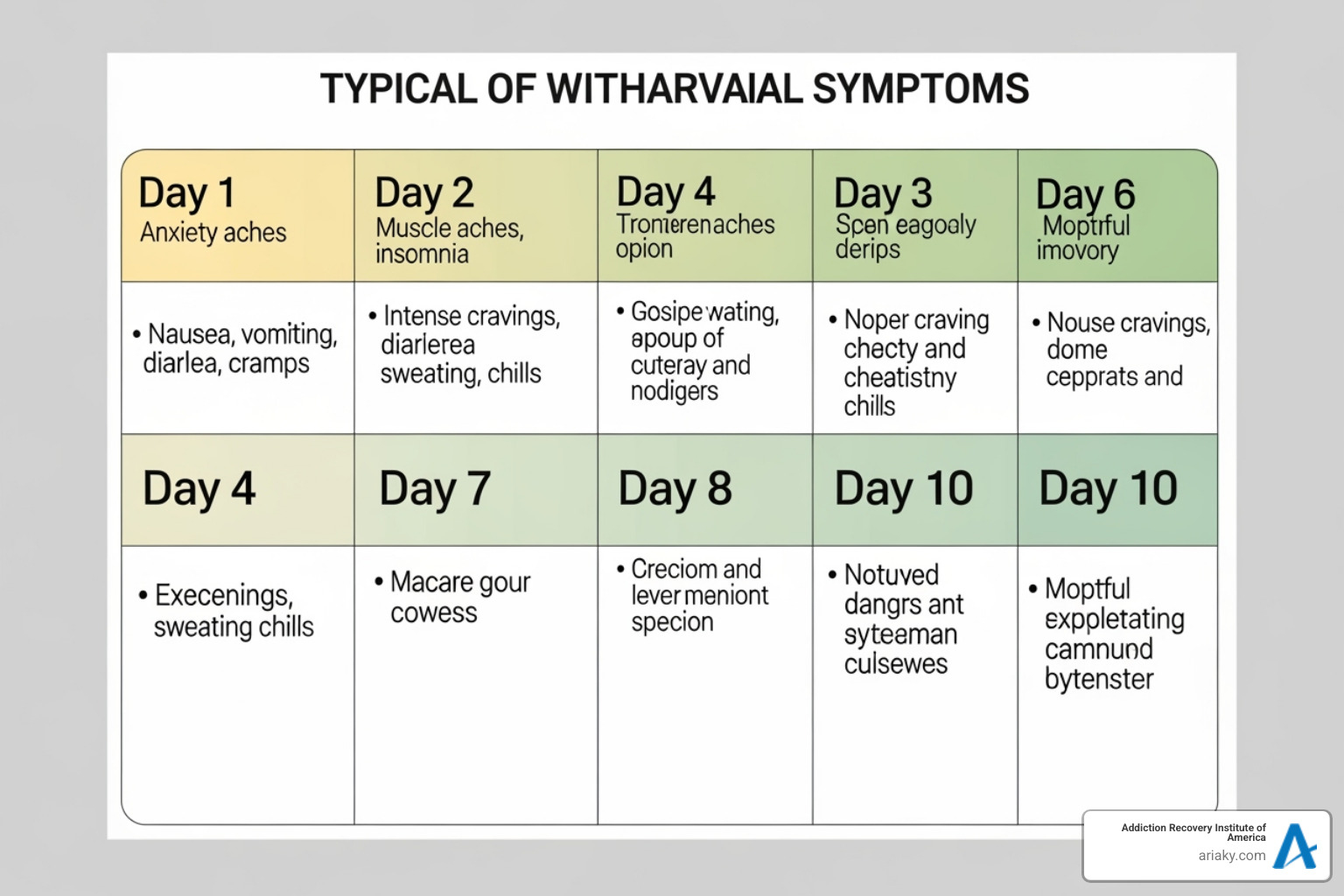Understanding the Critical First Step in Recovery from Opioid Dependence
Heroin detox is the medically supervised process of safely removing heroin from your body while managing withdrawal symptoms. It’s the essential first step toward breaking free from physical dependence on this powerful opioid.
Quick Facts About Heroin Detox:
- Timeline: Withdrawal symptoms typically begin 8-24 hours after last use and peak within 2-4 days.
- Duration: Acute symptoms usually subside within 7-10 days.
- Common Symptoms: Muscle aches, nausea, vomiting, sweating, anxiety, insomnia, and intense cravings.
- Safety: While uncomfortable, withdrawal is rarely life-threatening for otherwise healthy individuals.
- Medical Support: Medications like buprenorphine and clonidine can significantly ease symptoms.
- Success Factors: Professional supervision increases comfort and dramatically improves completion rates.
If you or someone you love is struggling with heroin addiction, understanding what detox involves can remove some of the fear. When heroin enters the brain, it binds to opioid receptors, altering brain chemistry. The body adapts, and stopping use triggers withdrawal as the system struggles to regain balance.
While heroin withdrawal itself is rarely dangerous, attempting to quit “cold turkey” carries serious risks. The biggest danger is relapse after detox when tolerance has dropped, which can be fatal. Professional detox provides medical monitoring, symptom management, and a structured environment that sets the foundation for lasting recovery. Detox alone won’t cure addiction, but it clears the physical dependency, making it possible to address the psychological roots of substance use. It’s not the finish line—it’s the starting gate.

Understanding Heroin Withdrawal
![IMAGE illustrating common withdrawal symptoms]
When you use heroin repeatedly, your brain chemistry changes. The drug attaches to your brain’s natural opioid receptors, which control pain and mood. Over time, your brain reduces its own production of feel-good chemicals and recalibrates its reward system around heroin’s presence. This leads to tolerance, meaning you need more of the drug to get the same effect. Eventually, you’re not using it to feel good, but just to feel normal. This is physical dependence.
When someone who is physically dependent stops using, their body protests. This readjustment period is called withdrawal. The discomfort can be so intense that many people use again simply to make it stop. This is why heroin detox under medical supervision is so important—you don’t have to go through it alone.
Signs and Symptoms of Heroin Withdrawal
The symptoms you’ll experience depend on factors like your usage history and overall health, but a predictable pattern exists. Early symptoms appear within 8 to 24 hours of the last dose, including agitation, anxiety, muscle aches, watery eyes, a runny nose, insomnia, sweating, and constant yawning.
As withdrawal progresses into days two through four, these symptoms peak. New symptoms emerge, such as severe nausea, vomiting, diarrhea, and abdominal cramping, which create a serious risk of dehydration. You may also experience goosebumps (the origin of the term “cold turkey”), a racing heart, and high blood pressure. Throughout this period, drug cravings can become psychologically overwhelming. While these symptoms are deeply unpleasant, they are generally not life-threatening for healthy individuals. However, the discomfort is a primary driver of relapse. You can learn more about the medical perspective on Opiate and opioid withdrawal.
Potential Complications of Withdrawal
While heroin withdrawal itself is rarely fatal, serious complications can arise, especially without medical support. Severe vomiting and diarrhea can lead to dehydration and a dangerous electrolyte imbalance, which can affect heart rhythm. There is also a risk of aspiration (breathing vomit into the lungs), which can cause pneumonia.
The most dangerous complication often occurs after detox. During this time, your tolerance to heroin drops dramatically. If you relapse and use your previous dose, your body can’t handle it, leading to a high risk of a fatal overdose. This is a critical reason why comprehensive treatment must extend beyond detox. Co-occurring medical or mental health conditions can also be exacerbated by the stress of withdrawal, requiring professional management. For more information, the resource Detoxification and Substance Abuse Treatment offers valuable insights.
The Heroin Detox Timeline: What to Expect
If you’re considering heroin detox, you likely want to know: “How long will this take?” While everyone’s experience is different, there is a general pattern. The timeline can vary based on the duration and amount of heroin use, your metabolism, and your overall health.
Heroin is a short-acting opioid, meaning withdrawal symptoms start soon after the last dose. The acute phase of heroin withdrawal typically lasts 3 to 10 days, with the worst symptoms peaking in the first few days. However, some psychological symptoms can linger for weeks or months, a condition known as Post-Acute Withdrawal Syndrome (PAWS). Medical supervision can make the process significantly more manageable. For comprehensive guidance, the Clinical Guidelines for Withdrawal Management provide evidence-based approaches.

First 24 Hours
Withdrawal symptoms from heroin typically begin within 8 to 24 hours after your last use, sometimes as early as 4 to 6 hours. The first day often feels like a severe flu. You may experience a runny nose, watery eyes, and excessive yawning. Sweating is common, along with deep, dull muscle aches. A sense of restlessness and anxiety also sets in, making it hard to get comfortable. These early symptoms are your body signaling that it’s beginning to recalibrate. In a monitored environment like Addiction Recovery Institute of America, we can provide comfort measures right away to manage these initial signs.
Days 2-4: The Peak
This is when heroin detox reaches its most intense point, usually on day two or three. The aches and pains can become excruciating. Your digestive system is severely affected, with intense abdominal cramping, diarrhea, and waves of nausea and vomiting. These symptoms can lead to dangerous dehydration, which is why medical supervision is critical. Sleep becomes nearly impossible due to insomnia and physical discomfort. You might also experience goosebumps, a racing heart, and spikes in blood pressure. The psychological challenge is equally intense, with powerful cravings for heroin. This is the period when professional medical support is most crucial to manage symptoms and prevent relapse.
Days 5-10: Acute Symptoms Subside
Around day five, the most severe physical symptoms start to ease. The vomiting and diarrhea lessen, and the intense muscle pain begins to fade, though some achiness and fatigue will likely remain. You will feel exhausted from the ordeal. Sleep may still be difficult as your brain’s sleep-wake cycle readjusts. Irritability and mood swings are also common as your brain chemistry continues to stabilize. While some restlessness and discomfort may linger, by day 7 to 10, most acute physical symptoms have largely resolved. Your appetite may return, and you can think more clearly. Completing acute detox is a major accomplishment, but it’s the first step. The psychological aspects of addiction require ongoing treatment, which is why a comprehensive recovery plan is essential.
Professional Heroin Detox: Programs and Medical Support
Choosing to pursue heroin detox is a courageous step, and one that is best taken with professional support. Attempting to detox alone can be an agonizing and dangerous experience. Professional medical support makes the process manageable and significantly increases your chances of success.
Safety is the most compelling reason for medically supervised detox. During heroin withdrawal, severe vomiting and diarrhea can lead to dangerous dehydration, and vital signs can fluctuate. For those with underlying health conditions, this can be an emergency. Our medical team monitors you around the clock to prevent complications. Another critical safety concern is the high risk of a fatal overdose if you relapse after detox, as your tolerance will have plummeted. A professional program connects you immediately to ongoing treatment, dramatically reducing this risk.
Beyond safety, medical supervision provides relief from the brutal symptoms of withdrawal. We use medications to ease the muscle aches, insomnia, and anxiety, making the process tolerable enough to complete. For more information on effective treatment, the National Institute on Drug Abuse provides excellent resources.
Types of Heroin Detox Programs
Different situations require different levels of care. Understanding your options is key.
- Inpatient detox is often recommended for heroin addiction. You stay at a specialized facility with 24/7 medical care, removed from triggers and access to drugs. This intensive level of care allows you to focus entirely on healing.
- Outpatient detox may be an option for those with a shorter history of use and a strong, sober support system. You live at home and visit a clinic for medication and check-ins. This offers more flexibility but requires navigating withdrawal in your usual environment.
- Medically-supervised detox is the essential component of any legitimate program, whether inpatient or outpatient. It means trained professionals monitor your health and manage symptoms with medication.
Choosing the right program depends on the severity of your addiction, your home environment, and any co-occurring medical or mental health conditions. At Addiction Recovery Institute of America, we assess these factors to create an individualized plan for you.
Medications Used During Heroin Detox
Medication-Assisted Treatment (MAT) combines FDA-approved medications with therapy to ease withdrawal and reduce cravings.
- Buprenorphine (Suboxone): A partial opioid agonist that relieves withdrawal symptoms and cravings without producing a high. It has a “ceiling effect,” reducing misuse potential. Many people continue buprenorphine as part of long-term recovery. SAMHSA provides detailed Buprenorphine Information.
- Methadone: A long-acting opioid that prevents withdrawal and cravings. It is dispensed in a controlled clinical setting and has been a life-changing treatment for many. You can learn more through Methadone Information from SAMHSA.
- Naltrexone: An opioid blocker that prevents the effects of heroin, making it an excellent tool for relapse prevention after detox is complete. You must be opioid-free for 7-10 days before starting it.
- Clonidine: A non-opioid medication that helps with physical symptoms like anxiety, muscle aches, and sweating.
- Symptomatic Medications: We also use other drugs to target specific symptoms like nausea, diarrhea, and insomnia.
Our medical team determines the best medication regimen for your situation, making detox a manageable process.
How to Know if You Need Treatment
Admitting you need help is often the hardest step. If you’re wondering if you need treatment, that question is often the answer. Clear signs include:
- Inability to control or stop use despite wanting to.
- Using more heroin than planned.
- Continued use despite negative consequences in your life (work, school, relationships, legal, financial).
- Needing more of the drug to feel the same effects (tolerance).
- Experiencing withdrawal symptoms when you try to stop.
- Spending most of your time obtaining, using, or recovering from heroin.
- Giving up activities you once enjoyed.
If these signs are familiar, you are not weak or a bad person. You have a medical condition, and help is available. The Substance Abuse and Mental Health Services Administration offers resources to Find Help with SAMHSA. Our team at Addiction Recovery Institute of America is also here to provide compassionate, confidential guidance.
Life After Detox: PAWS and Long-Term Recovery
Completing heroin detox is a major victory, but it’s the starting gate, not the finish line. The physical dependence is broken, but the psychological roots of addiction need ongoing attention. Think of it as clearing the foundation; now it’s time to build a new, sober life.
This next phase is about developing relapse prevention strategies, engaging in therapy, and building a strong support system. At Addiction Recovery Institute of America, we provide the tools and care you need to build a fulfilling life free from heroin. Research from the National Institute on Drug Abuse shows that effective treatment must address all aspects of a person’s life, which is what our programs are designed to do.
Understanding Post-Acute Withdrawal Syndrome (PAWS)
Weeks or even months after heroin detox, you may experience Post-Acute Withdrawal Syndrome, or PAWS. This is a real phenomenon caused by your brain slowly healing and recalibrating after long-term substance use. Symptoms can come and go in waves and may include:
- Persistent anxiety or depression
- Sleep disturbances and fatigue
- Mood swings and irritability
- Difficulty concentrating
- Intense drug cravings, often triggered by stress
These symptoms can last for months, but understanding that they are a normal part of brain healing is empowering. It’s not a personal failure, and you don’t have to face it alone. Patience, self-compassion, and professional support are key to navigating PAWS.
The Role of Ongoing Treatment and Support
Recovery from heroin addiction is not a solo journey. Ongoing treatment addresses the psychological and behavioral patterns behind the addiction.
- Cognitive Behavioral Therapy (CBT) is an evidence-based approach that helps you identify negative thought patterns and replace them with healthy coping strategies.
- Inpatient rehab provides an immersive, structured environment away from daily triggers, allowing you to focus entirely on healing. Our residential programs at ARIA Kentucky offer this level of care.
- Partial Hospitalization (PHP) and Intensive Outpatient Programs (IOP) are step-down levels of care that offer intensive treatment while allowing you to live at home or in a sober living environment. They help you practice recovery skills in the real world with strong therapeutic support.
- Support groups like Narcotics Anonymous and SMART Recovery offer invaluable peer connection with people who understand your journey. Sharing experiences in a non-judgmental space builds strength and community.
- Individual and group counseling provide safe spaces to explore personal challenges and learn from others.
The journey from heroin detox to lasting sobriety requires a multi-faceted approach. At Addiction Recovery Institute of America, we focus on individualized care that addresses the whole person, providing the tools and support necessary for you to heal and thrive.
Conclusion
If you’ve read this guide because you or a loved one is struggling with heroin addiction, know that there is real hope for a life beyond it. We’ve covered how heroin detox is the essential first step—the process of safely clearing the drug from your body while managing withdrawal.
We explored the science of physical dependence and the timeline of withdrawal, from the early flu-like symptoms to the intense peak and eventual subsiding of acute symptoms. Most importantly, we emphasized that you do not have to endure this alone.
Professional, medically supervised heroin detox is the safest and most effective path forward. With 24/7 monitoring and Medication-Assisted Treatment, the process becomes manageable, dramatically increasing your chances of success. But detox is just the beginning. Lasting recovery involves addressing the psychological roots of addiction through ongoing therapy, support groups, and relapse prevention planning.
At Addiction Recovery Institute of America, an accredited, AODE-certified addiction rehab center in Kentucky, we understand this journey. Our programs—from detox and residential treatment to PHP and IOP—are built on individualized care that treats the whole person. We see you as someone with a future worth fighting for, and we know that lasting sobriety is within your reach.
If you are ready to take that first brave step, we are here to help. There is no judgment, only compassion and a genuine desire to help you reclaim your life. The path forward begins now.
Begin your recovery with a professional heroin detox program


